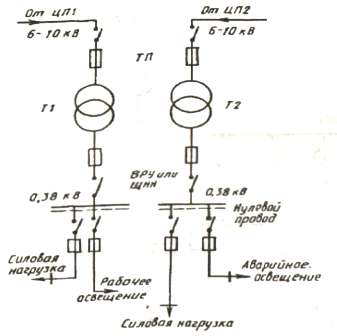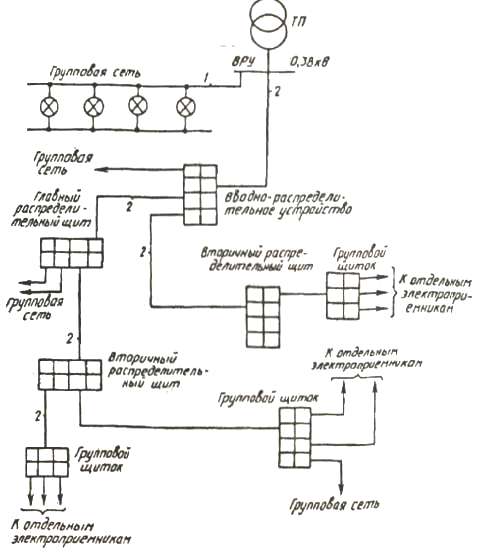Requirements for entrance devices, distribution points and panels for group lighting
The main switchboard is called a switchboard through which the entire building or its isolated part is supplied with electricity. The role of the main switchboard can be performed by an input switchgear or a low-voltage (0.38 kV) switchboard of a transformer substation.
A secondary switchboard is called a switchboard that receives electricity from the main switchboard or input switchgear and distributes it to distribution points or group panels of the building.
Distribution point, panel of the group names the point, the panel on which the protective devices and switching devices of individual electrical receivers or their groups (lamps, electric motors) are mounted.
The network that supplies electricity in residential and public buildings is called a distribution network.
In industrial buildings without natural lighting, it is not allowed to use networks supplying a power supply load to connect general, working, emergency or evacuation lighting. Emergency and escape lighting must be capable of being switched on at all times when the working lights are on, or automatically switched on when the working lights are switched off in an emergency. Handheld lighting devices with rechargeable or dry cells can be used as emergency and evacuation lighting.
Lighting networks laid from power sources, which are 0.38 kV busbars of transformer substations, to lighting fixtures, may consist of only a group network or of feeder and group networks.
A supply network is called a network from a switchgear with a voltage of 0.38 kV at a substation (busbars with a voltage of 0.38 kV) to an input switchgear, as well as from an input switchgear to the main switchboard and from a secondary switchboard to distribution points or group (Fig. 2).
A group network called the network that powers the lamps and sockets.
The input distribution device is called a set of structures, devices and devices installed at the entrance of the supply pipeline to the building or in its isolated part, as well as on the lines coming out of the input distribution device.

Rice. 1. Power supply for working and emergency lighting (TP — transformer substation, T1 and T2 — transformers, ASU — input-distribution device, SHCHNN — low-voltage circuit board).

Rice. 2. Schemes of networks of group (1) and power supply (2)
Entrances to buildings must be equipped with an entrance or entrance switchgear equipped with protective and control devices (with a current of more than 25 A).
Power lines with a voltage of 0.38 kV from substations to input-distribution devices are protected against short-circuit currents.
Input, input-distribution devices, main distribution boards are installed in special distribution rooms, dry basements, underground floors, cabinets with a lock, niches accessible only to service personnel. The room temperature should be at least + 5 ° C.
When placing entrance, entrance-distribution boards, distribution points and group boards outside the switchboard premises, they should be located in places convenient and accessible for service.
It is recommended to install distribution points and shields in niches, boxes. They must be covered with sheaths and have no open non-insulated live parts located closer than 0.5 m from pipelines, gas pipelines and gas meters.
To reduce the length and cross-section of the wires of the group network, the shields are installed, if possible, in the center of the lighting load.
Each group network extending from the panel is protected by fuses or automatic devices located on the panel, which are installed on all phases, as well as in the neutral conductors of two-wire lines and are designed for an operating current of no more than 25 A.
The maximum permissible power of the group network, when protected by fuses or circuit breakers, designed for a current of 25 A, with a lighting network voltage of 380/220 V is: 5 — 500 W for a two-wire network (one phase and neutral), 11000 W for three-wire network (two phases and zero) and 16500 W for four-wire (three phases and zero) or five-wire (three phases, zero working and zero protective).
Group lines supplying gas-discharge lamps with a unit power of 125 W or more, filament lamps up to 42 V of any power and incandescent lamps over 42 V with a unit power of 500 W or more may be protected by fuses or circuit breakers for current up to 63 A.
Each group network must provide phase connection with no more than 20 receivers: incandescent lamps, arc discharge fluorescent lamps (DRL), arc discharge iodide (DRI), sodium lamps. This includes installed electrical outlets.
For group lines supplying light moldings, panels, as well as lighting fixtures with fluorescent lamps, it is allowed to connect up to 50 lamps per phase. For lines supplying multi-lamp chandeliers, the number of lamps per phase is not limited.
In residential and public buildings, it is allowed to connect up to 60 incandescent lamps each with a power of up to 60 W. In group lines supplying lamps with a power of 10 kW or more, no more than one lamp should be connected to each phase.
A single-phase group lighting network is laid in small rooms, as well as in medium and large rooms when installing lamps with low-power incandescent lamps (up to 200 W) and fluorescent lamps.
A three-phase group lighting network is laid in large rooms where there are lighting fixtures located in continuous rows with incandescent lamps with a power of 500-1000 W, as well as arc and fluorescent lamps.
